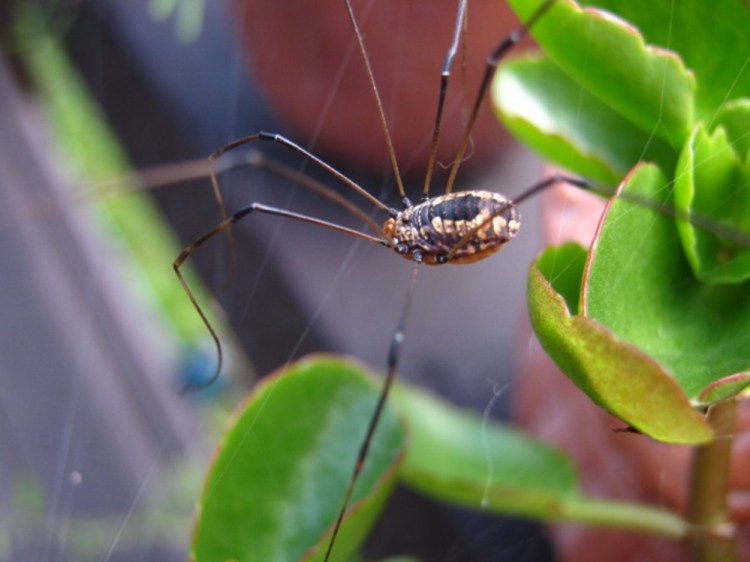Crawling all over the outside of everywhere this fall, as always, have been scavenging harvestmen, also known as daddy long-legs.
No one minds them at our house, the way some of us who are not me mind spiders. The main thing, I think, is that while spiders look like they’d tear your face off and gnash it down if they were only a little bigger, daddy long-legs don’t look the least bit fearsome. They amble around on these huge stilts acting like they’re more curious than anything else. I was told when very young — and I imagine most everybody else learned the same folklore — that daddy long-legs don’t bite, which I’m pretty sure made me feel well-disposed toward them.
It turns out this folklore is true — they don’t bite humans. Like spiders, they’re arachnids, not insects, and have eight legs. But they’re a different order, Opiliones, while spiders are of the order Araneae. (Ticks and mites are arachnids, too, but of the order Acarina.)
Hardly any spiders bite humans, either, by the way, and with a few unusual exceptions do no harm even when they do give a tiny frightened nip with their side-to-side jaws, or chelicerae. But the daddy long-legs lack fangs or venom, and they’re prowling around looking for unvigilant sowbugs, other small insects, mites, newly dead worms, even spiders, to eat, and some of them nibble decaying plants and fungi.
Their long, thready legs are as important as they look. In addition to carrying their little bodies around (they actually do have two sections, like spiders, but the joint between the sections is so fat that harvestmen look like they’re all head), the legs have olfactory and breathing organs. They also have stink glands under the first and second pairs, sort of like arachnid skunks, and some of them apparently use the little appendages called pedipalps, around their mouths, to mix the acrid-smelling secretion with saliva and throw it at predators. Nasty crafty.
The second pair of legs is the longest and most important. They’re used like antennae to feel out the ground for things to eat. They can lose one of the first, third or fourth sets of legs and hobble on, even though lost legs don’t regenerate, but damage to one of the second pair is apparently usually fatal. Interestingly, while their mating procedure starts off as basically a surprise attack by the male, once the brief copulatory embrace is underway, the couple gently stroke each other with those long legs.
There’s something relaxed, familiar and domesticated about daddy long-legs. In Maine we most commonly see the Eastern harvestman and the brown harvestman. They scoot around the wood pile, along the railing of the deck and over the garden plants with a kind of leisurely arachnoid grace. Maybe it seems graceful because I’ve never seen them eating or throwing spit at predators. I’ve never seen them gather at night, either. But apparently they sometimes on cold nights gather in huge numbers in a protected place like the side of a building with their legs interlaced in “a nightmarish hairball,” as one field guide puts it. No one knows exactly why they do this. Maybe for warmth. Maybe for community purposes, which is kind of, well, touching when you daydream about it a little bit.
They’ve been abundant around our house this fall, as usual. Most of them will not live through winter, but the eggs have been pushed into soil, moss or rotten wood, and another generation will amble out next summer, relieve us of some of our bugs, and help give the backyard the familiar shape of fall again.
Dana Wilde lives in Troy. His writings on Maine’s natural world are collected in “The Other End of the Driveway,” available from online booksellers or by contacting the author at naturalist@dwildepress.net. Backyard Naturalist appears the second and fourth Thursdays each month.
Send questions/comments to the editors.




Comments are no longer available on this story